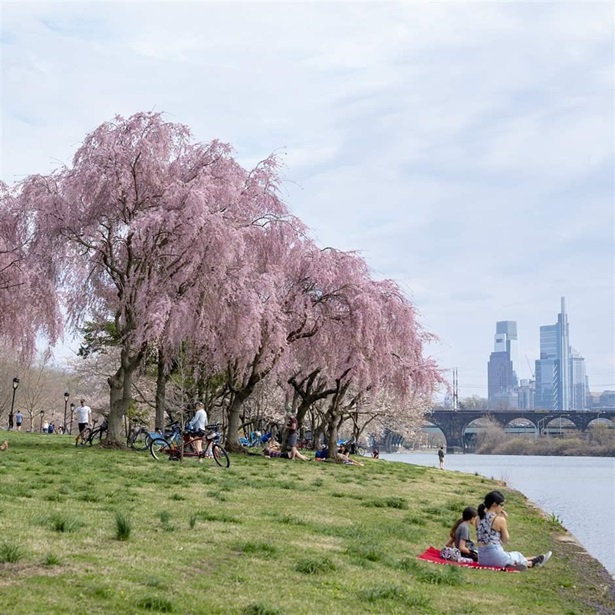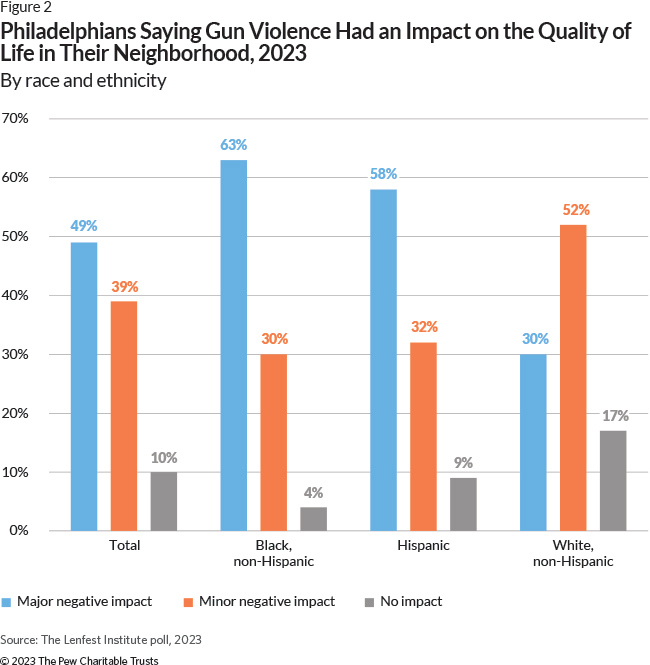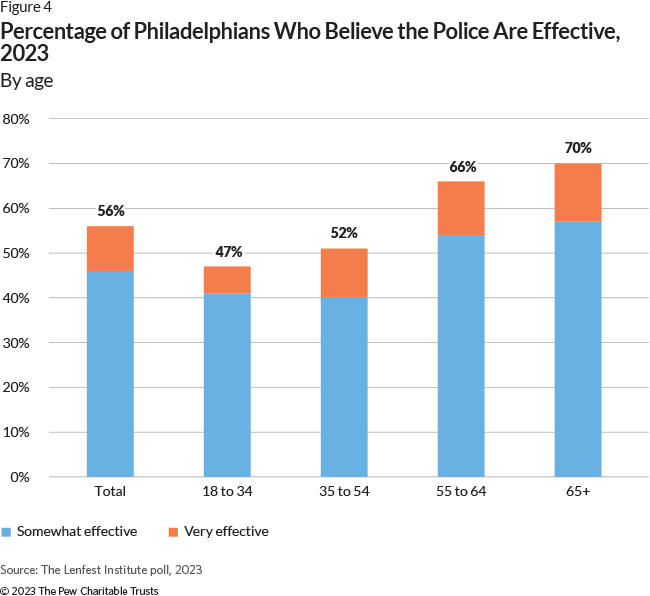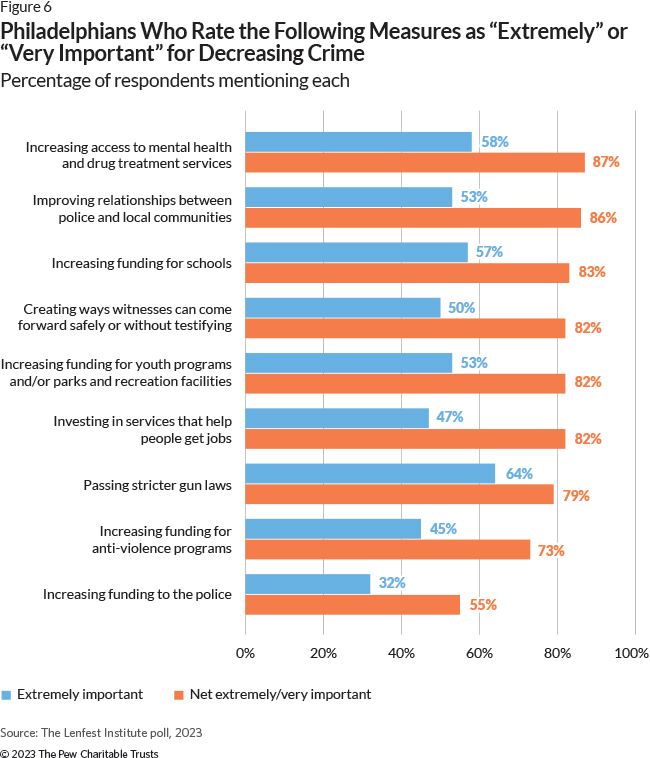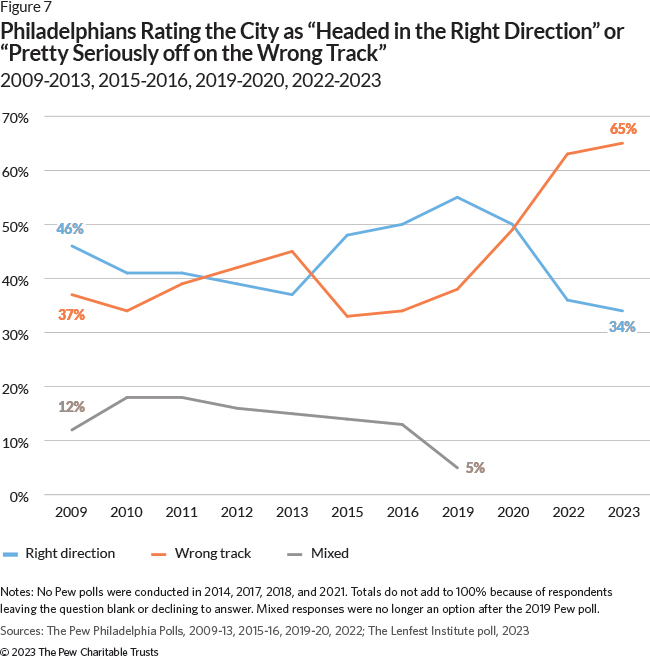Poll: Philadelphians Want City Leaders to Tackle Crime
Most residents surveyed continue to think city is on the wrong track
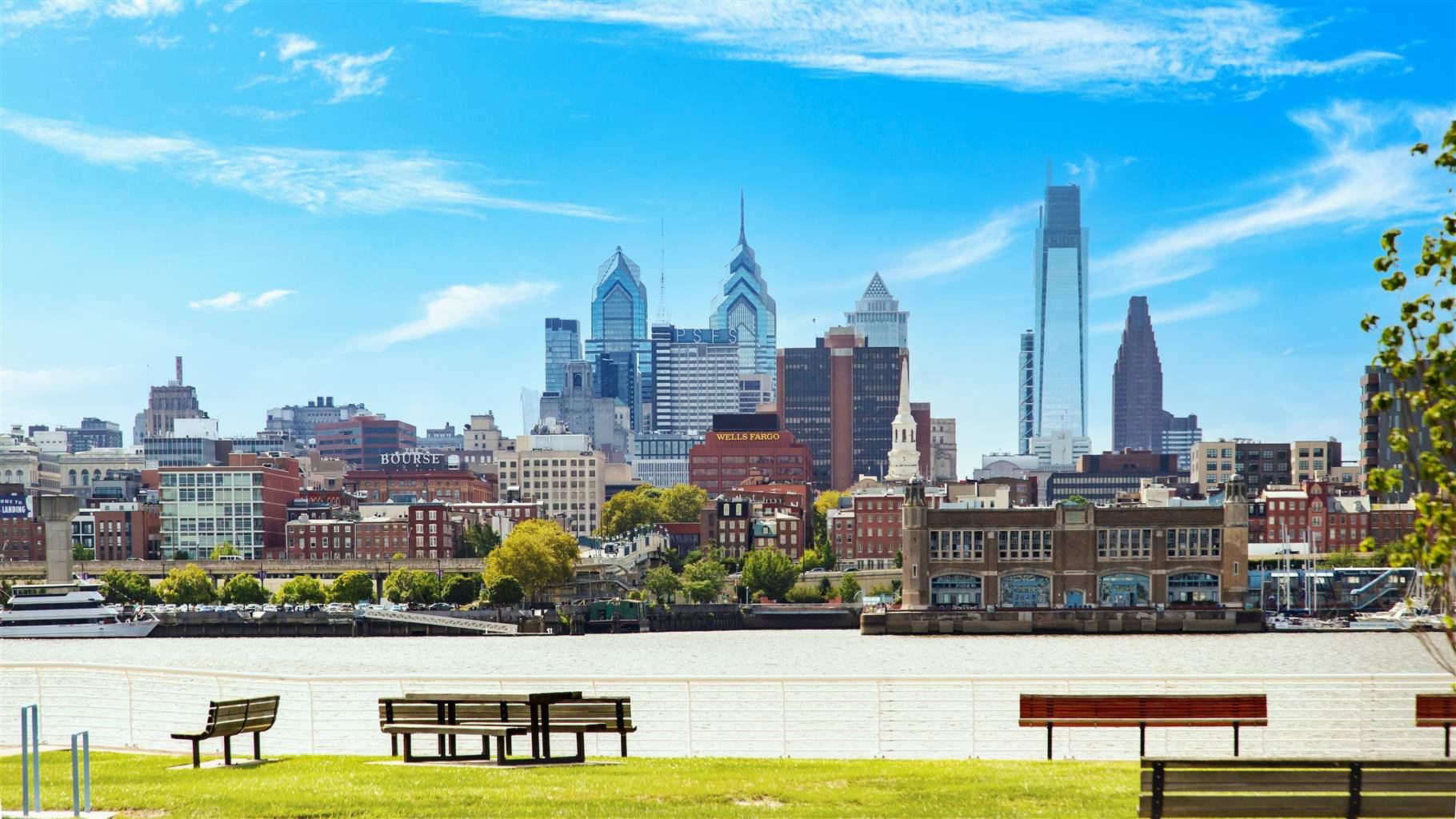
Overview
Amid a continuing surge in gun violence, a recent poll found that Philadelphians from all backgrounds want their elected leaders to prioritize reducing the city’s crime rate in the coming years. Residents, especially those most directly affected by gun violence, expressed anxiety about their safety and the quality of life in their neighborhoods. These concerns follow multiple years of historically high homicide rates.
By a slimmer margin, city residents cited education and the economy, respectively, as the next most important issues that officials should address. As with other cities, many Philadelphians lost their jobs during the height of the pandemic, and its impacts on employment, physical and mental health, and education still linger. The poll found that the problems of homelessness and opioid addiction are also sources of concern among residents.
Against this backdrop, a strong majority of respondents expressed pessimism about the city’s future, continuing a trend that began at the start of the pandemic. Sixty-five percent of Philadelphians said that the city is on the wrong track—slightly more than last year, and up from 38% in 2019. This is the highest percentage recorded since Pew first asked this question in 2009.
The Lenfest Institute for Journalism poll, conducted by SSRS, an independent research company based in Glen Mills, Pennsylvania, from Dec. 5, 2022, to Jan. 9, 2023, found that 64% of Philadelphians reported hearing a gunshot in their neighborhood over the previous year. Nearly half (49%) say that gun violence has a major negative impact on the quality of life in their neighborhood, with higher percentages among Black and Hispanic residents.
Two-thirds of residents say the city doesn’t have enough police. However, when asked about ways to decrease crime, just over half (55%) said that funding the police was “extremely” or “very important”—the lowest of all measures tested. Increasing access to mental health and drug treatments and improving the relationship between the police and the communities they serve were rated more highly.
Although strong majorities of Philadelphia residents also cited education and the economy as critical issues for elected officials to address, their priorities differ depending on their income. Individuals with a household income of less than $50,000 said they favor a higher minimum wage and a reduction in the wage tax. They also were more likely to rate the city as an “only fair” or “poor” place to live than those with a household income of at least $100,000.
The survey—conducted for The Lenfest Institute by SSRS—used a mixed mode survey of mail, online, and inbound telephone calls. SSRS collected data from 1,247 Philadelphia residents age 18 and older; 939 filled out the questionnaire online, 268 completed via mail, and 40 via telephone. The survey was conducted in both English and Spanish. The margin of error is plus or minus 3.5 percentage points and the survey had a response rate of 11.1%. Analyses in this report reflect weighted percentages among valid responses. The survey questionnaire was informed by focus groups that The Lenfest Foundation convened in September 2022.
Although the poll included some questions that Pew has also used for previous surveys, recent Pew studies have been conducted through the mail and online. Pew’s surveys from 2019 and earlier also used inbound phone calls.
Priorities for the City in the Next Two Years
The survey listed seven issues and asked Philadelphians what degree of importance the mayor and other elected officials should assign to each—and how they should address it.
Eighty-nine percent of residents said that “crime such as gun violence, carjackings” should be city leaders’ top focus over the next two years. (See Table 1.) This was the leading response across all racial and ethnic groups and age, income, and education levels.
Table 1
Percentage of Philadelphians Rating Each Issue as a Top Priority for Mayor and Elected Officials
By race and ethnicity
| Total | Black, non-Hispanic | Hispanic | White, non-Hispanic | |
|---|---|---|---|---|
| Crime | 89% | 93% | 87% | 87% |
| Education | 75% | 85% | 78% | 65% |
| Economy and jobs | 65% | 82% | 61% | 48% |
| Homelessness | 59% | 70% | 62% | 47% |
| Affordable housing | 57% | 76% | 57% | 38% |
| Opioid use | 55% | 61% | 66% | 47% |
| City services and infrastructure | 51% | 56% | 64% | 41% |
Note: Respondents were asked to rate each choice among four categories: “top priority,” “important but lower priority,” “not too important,” and “should not be addressed.” They could select more than one top priority.
Source: The Lenfest Institute poll, 2023
Philadelphians were also asked about specific initiatives to address each of these concerns. When asked about educational investments, residents voiced a preference for ensuring that students have school supplies, technology, and internet access (75%), funding for improvements to school infrastructure (73%), and vocational and job training (72%).
On jobs and the economy, residents expressed the most support for boosting the city’s minimum wage. As of April 2023, Philadelphia’s minimum wage is $7.25 an hour, which is set by the state and which the city has no power to change. Seventy-six percent of Philadelphians said raising it should be a top priority, including 85% of residents with an annual household income of less than $50,000.
Among other economic policy priorities, 72% of residents, including 84% of Black Philadelphians, said helping Philadelphians get jobs should be a top priority. Fewer residents supported efforts to make the city more attractive to investors (43%) and increase tourism (31%).
Sixty percent of Philadelphians said it should be a top priority to reduce the city’s wage tax, which city leaders have direct power to change. Hispanic (67%) and Black, non-Hispanic (63%) Philadelphians were more likely to support a wage tax reduction than White, non-Hispanic residents (51%). When compared by income, significantly more residents with annual household incomes of less than $50,000 selected reducing the wage tax than those with higher incomes. (See Figure 1.) In Pew’s 2022 poll, Philadelphians with incomes under $50,000 were more likely, when compared with those with higher incomes, to rate the wage tax as fair.
Public Safety and Gun Violence
Gun violence continues to afflict Philadelphia and dominate public conversations, as reflected by residents’ high rating for where elected leaders should focus their efforts. Last year, 516 people were killed, most from gun violence, and the city had 2,255 shooting victims, only slightly less than in 2021.
As with Pew’s January 2022 poll, nearly two-thirds of Philadelphians said that they had heard gunshots in their neighborhood during the previous 12 months—with nearly 78% of Black, non-Hispanic and 70% of Hispanic residents indicating that they had experienced this situation, compared with just 48% of White, non-Hispanic residents.
Almost half of Philadelphia residents said that gun violence has had a major negative impact on the quality of life in their neighborhoods, a slight uptick from when Pew asked this question in 2022 (42%). But when the responses are disaggregated by race and ethnicity, Black and Hispanic residents were far more likely than White residents to agree with the statement that gun violence has had a major negative impact on the quality of life in their neighborhoods. (See Figure 2.) Since 2015, 84% of shooting victims in Philadelphia have been Black or Hispanic men.
Those with higher incomes and more formal education were less likely to note a negative impact. Just 29% of those with incomes greater than $100,000 said gun violence has had a major negative impact on the quality of their life, compared with 59% of those with a household income under $50,000. And only 35% of those with a college degree or higher cited a major negative impact on their quality of life, compared with 61% of those with a high school degree or less.
Despite these differences, there is broad agreement that the problem of gun violence in Philadelphia has gotten worse over the last three years; 85% of residents agree—a sentiment shared across races, incomes, education levels, and ages, and the same percentage as Pew’s 2022 poll.
When asked why gun violence remains a problem in Philadelphia, residents identified the ease of accessing guns and drug dealers and criminal gangs as top reasons (see Figure 3). Other commonly cited reasons included a lack of jobs and opportunity, low quality of education for youth, conflict on social media, hopelessness, and a lack of community.
Views on Police
As the city grapples with gun violence, Philadelphians have called for greater accountability from city officials over how funding for anti-violence programs is distributed, how the police department is allocating its resources and deploying officers, and how public safety is prioritized among competing policy goals.
To that end, 56% of Philadelphia residents said they believe the police are effective at their jobs, but only 10% characterized them as “very effective.” Older Philadelphians generally expressed more confidence in the police than other age groups did. (See Figure 4.)
The survey also explored residents’ attitudes on the number of police officers in the city—and whether they believe more or fewer are needed. Since 2020, the percentage of Philadelphians who say the city “doesn’t have enough police” has increased 22 points. (See Table 2.)
Table 2
Residents’ Views on the Size of Philadelphia’s police force
2020, 2022, 2023
| 2020 | 2022 | 2023 | |
|---|---|---|---|
| Doesn't have enough police | 45% | 61% | 67% |
| Has about the right number of police | 39% | 31% | 28% |
| Has too many police | 14% | 8% | 5% |
| Don't know | N/A | N/A | * |
| Refused/blank | 3% | 1% | * |
Sources: The Pew Philadelphia polls, 2020 and 2022; The Lenfest Institute poll, 2023
Black residents (75%), those 55 and older (81%), and those who said gun violence has had a major negative impact on their neighborhoods (75%) were more likely to believe the city doesn’t have enough police. (See Figure 5.)
However, when asked how important various measures are for lowering crime, increasing funding to the police was selected noticeably less often than other measures. (See Figure 6.) This response held across demographic groups—with residents of varying incomes, races, educational attainment, and age all identifying measures other than increasing funding to the police as important for decreasing crime.
Although there was broad agreement on most of the crime interventions, Black non-Hispanic (81%) and Hispanic (79%) Philadelphians more strongly favored raising funding for anti-violence programs than White residents (60%). Overall, Black Philadelphians were significantly more likely than White Philadelphians to cite all these crime intervention measures as important. In addition, Hispanic Philadelphians were more likely to select improving relationships between the police and local communities—as well as boosting funding for youth programs—than were White Philadelphians.
Response to Opioid Use Disorder
In 2022, an estimated 1,400 people died from a drug overdose in Philadelphia, the vast majority from opioids such as fentanyl and heroin.
Ninety-one percent of Philadelphians surveyed said that opioid use should be a “top” or “important” priority for the city’s elected leaders over the next two years; more than half of all respondents (55%) indicated it should be a top priority. When asked about how to respond to opioid drug use, more than 6 in 10 Philadelphians strongly preferred providing more free mental health services and more drug treatment and recovery services. Only around a quarter of residents want the city to approve safe-injection sites or arrest drug users.
When comparing responses by age, there was the most variation about arresting people who sell drugs, with fewer than half of residents ages 18 to 34 seeing that as a top priority, compared with nearly three-quarters of residents age 55 and older. (See Table 3.)
Table 3
Philadelphians’ Views on the Top Priority for Responding to Opioid Drug Use, 2023
By age
| Total | 18 to 34 | 35 to 54 | 55 to 64 | 65 and older | |
|---|---|---|---|---|---|
| Providing more free mental health services | 68% | 74% | 68% | 64% | 62% |
| Providing more drug treatment and recovery services | 63% | 67% | 63% | 58% | 60% |
| Arresting people who sell drugs | 59% | 46% | 58% | 73% | 72% |
| Promoting education around drug use | 55% | 57% | 54% | 49% | 58% |
| Approving safe-injection sites | 27% | 38% | 24% | 14% | 22% |
| Arresting people who use drugs | 22% | 23% | 22% | 22% | 20% |
Note: Respondents could select more than one top priority.
Source: The Lenfest Institute poll, 2023
City Services
Among direct services provided by city government, 72% said that fixing roads and potholes should be a top priority for leaders. These infrastructure measures are a higher priority for people over age 55 (80%) and lifelong Philadelphia residents (79%) than for residents ages 18 to 34 (68%).
About two-thirds of Black and Hispanic residents emphasized reducing illegal dumping, compared with around half of White residents. A majority of Black and roughly half of Hispanic and White Philadelphians say improving public transportation efficiency should be a top priority. Overall, increasing parking availability was ranked the lowest of the offered options, with just half indicating that it should be considered a top priority for leaders. (See Table 4.)
Table 4
Philadelphians’ Prioritization of Select City Services
| Total | Black, non-Hispanic | Hispanic | White, non-Hispanic | |
|---|---|---|---|---|
| Fixing roads and potholes | 72% | 79% | 75% | 64% |
| Reducing illegal dumping of garbage | 60% | 68% | 72% | 48% |
| Improving public transportation efficiency | 55% | 61% | 54% | 49% |
| Improving parks and recreation centers | 52% | 62% | 55% | 40% |
| Improving trash collection | 50% | 56% | 63% | 39% |
| Increasing parking availability in residential and commercial areas | 48% | 56% | 57% | 35% |
Note: Respondents could select more than one top priority.
Source: The Lenfest Institute poll, 2023
Housing
Housing remains a struggle for many Philadelphians. Eighteen percent indicated that they have experienced either homelessness or housing instability in the past three years. And 41% of those who said they are not experiencing homelessness or housing insecurity said it was nonetheless “very or somewhat difficult” to afford their rent or mortgage payment. Among those who have experienced housing instability or homelessness in the past three years, nearly three-quarters (74%) said it was “somewhat or very difficult” to pay their rent or mortgage. Overall, renters (53%) were more likely to report challenges affording their housing costs than homeowners (32%).
According to U.S. Census data, 57% of households in Philadelphia that rent and 27% of households that own their homes are defined as “cost burdened,” spending 30% or more of their income on housing.
Views of the City
In 2023, 54% of Philadelphians said they would rate the city as an “excellent” or “good” place to live, unchanged from Pew’s polling last year, but still down from 66% from 2020. More than 6 in 10 Philadelphians with at least a college degree (65%) and White residents (63%) call the city an “excellent” or “good” place to live, significantly more than the percentage of respondents who have lived in Philadelphia their entire lives (48%) and those who said gun violence has a major negative impact on their community (41%).
Philadelphians’ views of the city’s direction remain pessimistic, with just 34% saying the city is headed in the right direction. Sixty-five percent of residents said it is on the wrong track. (See Figure 7.) And 71% of Philadelphians who have lived in the city their whole lives and 74% of those who said gun violence has a major impact on their neighborhood say the city is “pretty seriously off on the wrong track.”
About this brief
This brief was written and prepared by Katie Martin and Jason Hachadorian from Pew’s Philadelphia research and policy initiative. Sandra Shea, a senior officer with the initiative, edited the brief, along with Anne Usher and Tricia Olszewski. The firm SSRS conducted the survey. The brief benefited from the comments of two independent reviewers: Cliff Zukin, professor of public policy and political science at the Edward J. Bloustein School of Planning and Public Policy at Rutgers University, and Everett Gillison, director of employee and labor relations at the Defender Association of Philadelphia. The brief does not necessarily reflect the opinions of these individuals or their institutions.


America’s Overdose Crisis
Sign up for our five-email course explaining the overdose crisis in America, the state of treatment access, and ways to improve care
Sign up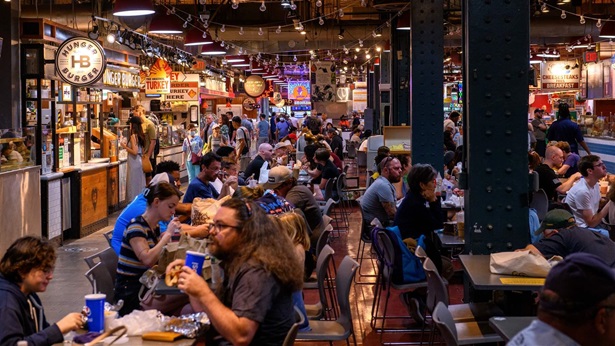
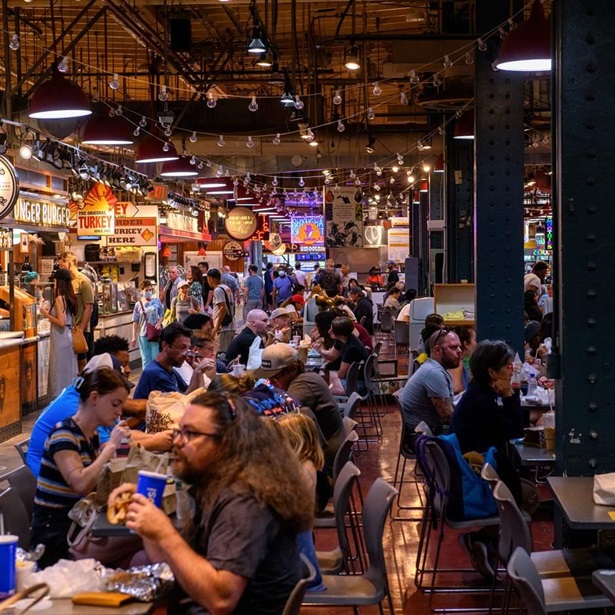
Philadelphia 2023: State of the City
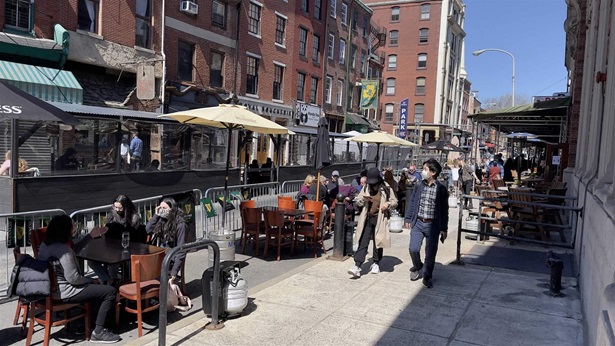
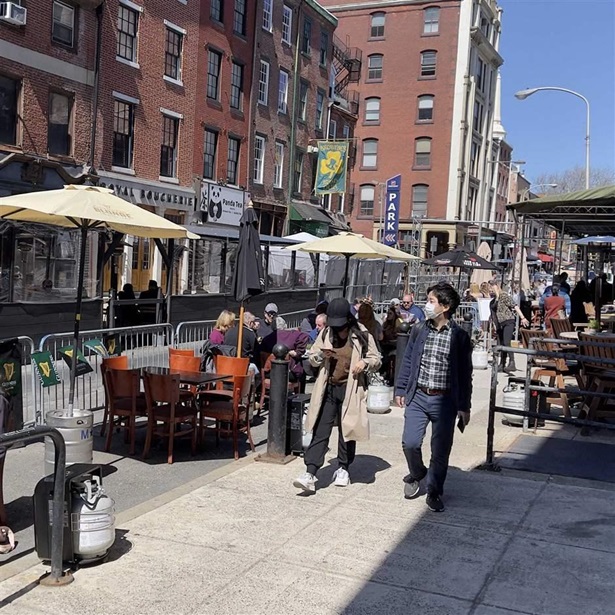
Gun Violence, COVID-19 Have Hit Philadelphians Hard

